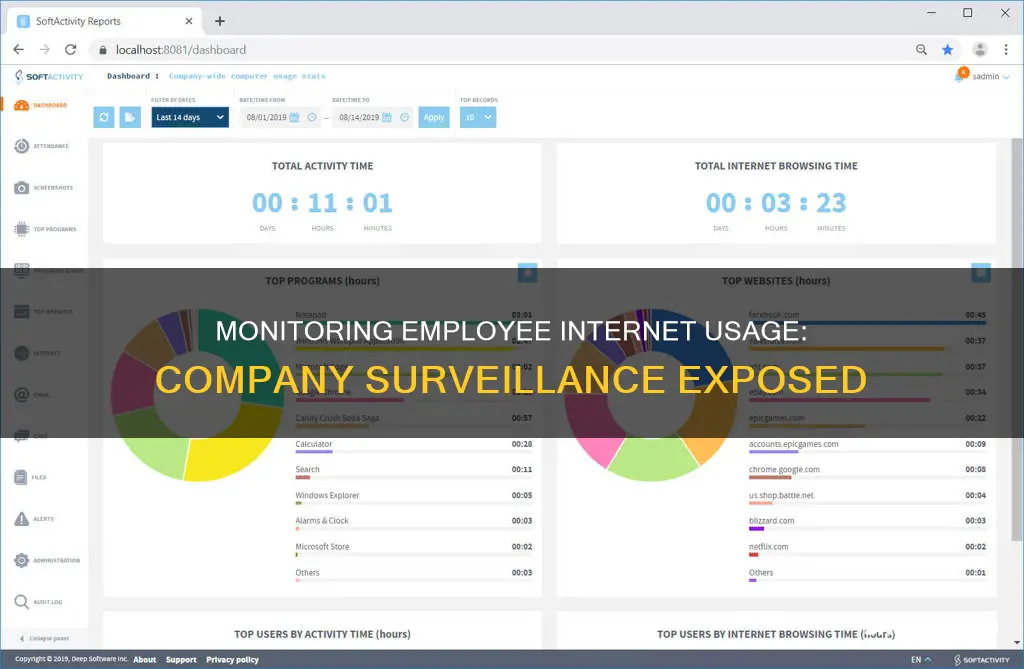
Companies can monitor their employees' internet usage in several ways, including through employee monitoring software, network monitoring, and time-tracking software. These tools allow employers to track internet usage patterns, log websites visited, monitor applications used, and analyse bandwidth usage. While this monitoring can improve productivity and security, it also raises privacy concerns, and employers must balance monitoring with respecting employee privacy. Additionally, companies should establish clear policies regarding internet monitoring and obtain employee consent to comply with legal and ethical obligations.
| Characteristics | Values |
|---|---|
| Software | WorkTime, Teramind, SoftActivity |
| Data collected | Screenshots, video recordings, keystrokes, websites visited, time spent on websites, applications used, files uploaded or downloaded, emails, chat messages |
| Data storage | Stored on the employee's computer or a centralized server |
| Reporting and analysis | Dashboards, activity logs, application usage, website categorisation, time tracking software, custom reports |
| Alerts and notifications | Set up for attempts to access prohibited sites or content |
| Legal and ethical implications | Must be transparent, gain consent, and adhere to local regulations |
What You'll Learn

Monitoring software
WorkTime is a non-invasive monitoring software that provides an alternative to invasive functions such as screenshot recording. It records the employee's system login name, the time and duration of internet use, and the history of visited websites. WorkTime categorizes websites as either productive or unproductive and helps companies save money by reducing unproductive time.
GlassWire is a free monitoring tool that allows users to keep track of their system and network activity. It provides notifications when apps or processes access the internet without prior approval and allows users to set various restrictions and block individual apps.
Net Guard is a popular free app available for Windows OS and Android devices that helps users monitor their monthly internet traffic. It allows users to set a traffic limit and avoid going over their monthly bandwidth threshold.
In addition to these tools, there are also built-in monitoring tools available on smartphones and tablets that allow users to monitor their internet usage. For example, on an iPhone, users can go to the "Cellular" section of the Settings app to see how much data each app has used and set usage limits.
Overall, monitoring software provides companies with insights into their employees' internet activities and helps improve productivity and reduce costs associated with unproductive time.
Monitoring Power Usage: Simple Steps for Your Home
You may want to see also

Ethical considerations
Monitoring employees' internet usage is a complex issue that requires careful ethical consideration. While employers have legitimate interests in ensuring company resources are used appropriately and safeguarding against legal issues, they must also respect employees' privacy. Here are some key ethical points to consider:
Transparency and Notice
Employers should ensure that employees are aware of and understand the monitoring practices in place. This includes providing written notice of the company's internet usage policies, outlining the reasons for monitoring, the methods used, and any potential consequences of inappropriate internet use. Transparency helps to maintain trust and respect between employers and employees.
Proportionality and Purpose
The monitoring practices should be proportional to the company's stated purposes. For example, if the primary concern is to prevent illegal or inappropriate activities, the monitoring should focus on detecting such behaviours rather than monitoring every employee's internet usage indiscriminately. The purpose of monitoring should be clearly defined and communicated to employees.
Minimising Privacy Intrusions
Employers should strive to minimise privacy intrusions when monitoring internet usage. This could include using non-invasive monitoring technologies, such as those that do not record personal data or private content, and avoiding continuous video surveillance. Respecting employees' privacy can help maintain a positive and loyal work environment.
Blocking or Restricting Access
Instead of solely relying on monitoring, employers can consider implementing measures to block or restrict access to specific websites or online activities that are unrelated to employees' jobs. This proactive approach can help reduce the need for extensive monitoring while still achieving the desired outcome of appropriate internet usage.
Productivity vs Privacy
A key ethical challenge is balancing the company's interest in maintaining productivity with employees' privacy rights. While monitoring can help improve productivity by reducing time spent on non-work-related activities, it should not be used as a means of excessive surveillance that invades employees' personal space. Employers should consider other factors affecting productivity, such as work processes and employee well-being, rather than solely relying on monitoring as a solution.
Legal Compliance
Employers must also consider the legal implications of monitoring employees' internet usage. While the legality of monitoring practices may vary depending on the country and specific legislation, it is crucial to ensure compliance with relevant privacy and data protection laws. Seeking legal advice and staying informed about applicable regulations are essential to maintaining ethical and legal standards.
Monitoring WiFi Usage: Track, Analyze, and Optimize Your Network
You may want to see also

Employee productivity
Monitoring employee internet usage is a common practice among companies, and it offers several benefits related to employee productivity. Firstly, it helps identify productivity issues by tracking the websites employees visit and the time spent on each site. This information can be used to block or deter employees from accessing unproductive or time-wasting websites during work hours, increasing their focus on work-related tasks.
Additionally, monitoring tools can provide insights into how employees spend their workday, including their task management and break times. This helps hold employees accountable for their time management and can identify those who may be taking excessive breaks or too long to complete tasks. As a result, companies can expect to see an increase in employee productivity and a reduction in lost productivity costs.
Furthermore, monitoring employee internet usage can help identify potential blockers to productivity, such as excessive time spent on non-work-related websites or social media platforms during work hours. With this data, companies can implement targeted training programs or policies to address these issues and improve overall efficiency.
Another benefit of monitoring is the ability to track bandwidth consumption. Monitoring tools can help identify potential malware threats by detecting high network activity, which may indicate a malware attack. This not only helps protect the company's network but also ensures employees are not wasting time on compromised websites or dealing with the after-effects of a security breach.
Lastly, employee monitoring software can provide insights into employees' skills and knowledge gaps. By understanding areas where employees may lack proficiency or spend excessive time, companies can develop targeted training programs to address these gaps and improve overall performance and productivity.
While monitoring employee internet usage has benefits, it is essential to consider privacy concerns and establish clear and transparent policies. Companies should also ensure they obtain the necessary consent and adhere to legal requirements to avoid ethical and legal issues.
Monitoring GPU Usage: A Comprehensive Guide to Tracking Performance
You may want to see also

Security risks
Unchecked internet usage in the workplace can increase security risks, impact productivity, and compromise company resources. Monitoring employee internet activity can help mitigate these risks, but it must be done ethically and with the appropriate tools.
Malware, Viruses, and Data Breaches
Harmful downloads, compromised websites, and phishing attacks can result in malware, viruses, and data breaches. For example, an employee could unintentionally install spyware by downloading unauthorized software. Unmonitored and poorly trained employees are also more likely to fall victim to phishing scams, which can compromise workplace systems and lead to significant data loss.
Insider Cybersecurity Threats
Insider cybersecurity threats, or internet security concerns that arise from an organization's employees, pose a significant risk. In fact, 74% of organizations are vulnerable to such threats. Unmanaged internet access can lead to employees violating company IT policies, work hours policies, and harassment policies. For example, employees accessing explicit websites or gambling services would go against acceptable use policies.
Bandwidth Issues
Excessive bandwidth-intensive streaming and downloads can slow internet speeds for all users. Large file downloads or multiple employees streaming video content can significantly impact business connectivity.
Reputational Damage
In extreme cases, employees may post content online that reflects poorly on the company. For instance, an angry employee could spread false claims about the company on social media, damaging its reputation.
Privacy Concerns
Employee monitoring tools can help mitigate security risks, but they also raise privacy concerns. Tracking an employee's internet activity, especially through methods like keystroke logging, can be seen as an invasion of privacy. Organizations must carefully navigate the balance between monitoring for legitimate business purposes and respecting employee privacy.
Monitoring Data Usage on iPhone: Tips and Tricks
You may want to see also

Compliance and legal issues
In the US, the Electronic Communications Privacy Act of 1986 (ECPA) is the key federal law governing the monitoring of electronic communications in the workplace. The ECPA allows employers to monitor communications if they can present a legitimate business reason for doing so. Additionally, the ECPA permits additional monitoring if employees give consent, although this provision can be tricky as it may be interpreted to allow monitoring of personal communications.
The ECPA sets the minimum restrictions on employee monitoring, and individual states can impose greater limitations. For example, in Connecticut, employers must provide advance written notice specifying the types and methods of monitoring. Several state constitutions, including California, Florida, Louisiana, and South Carolina, explicitly guarantee citizens a right to privacy, which may give employees heightened expectations of privacy.
When monitoring internet usage, companies should also be mindful of other federal and state laws, such as data privacy laws like the California Privacy Rights Act. Additionally, companies must comply with common-law protections against invasion of privacy, which vary by jurisdiction. Courts typically weigh the employee's reasonable expectation of privacy against the employer's legitimate business interest in conducting the surveillance.
To ensure compliance and respect employees' privacy rights, companies should implement transparent monitoring policies. This includes informing employees that they are being monitored and obtaining their consent, especially for more invasive practices such as keystroke logging and screenshot capture. Companies should also be cautious about acquiring too much personal information, as this may violate privacy laws such as HIPAA.
In addition to legal compliance, companies should also consider the ethical implications of employee monitoring. While monitoring can help improve productivity and security, it can also create distrust and negatively impact employee morale and happiness. A balanced approach that respects employees' privacy while achieving legitimate business purposes is essential.
Monitoring Electricity Usage: A Guide to Tracking Your Power Consumption
You may want to see also
Frequently asked questions
Monitoring employee internet usage can help improve employee productivity, ensure compliance with company policies, and prevent unauthorized activities. It can also help protect sensitive company data and systems, as well as uphold legal and regulatory compliance.
Companies can use employee monitoring software (EMS) to track internet usage patterns, record screens, log websites visited, monitor applications, and log keystrokes. They can also use network-level monitoring tools such as firewalls, web filters, network analytics, and deep packet inspection.
Monitoring employee internet usage raises privacy concerns and must be done ethically and with consent. Organizations should inform employees about monitoring policies, obtain consent, anonymize data when possible, and store data securely.
The legality of monitoring employee internet usage varies by jurisdiction. In the US, broad monitoring is generally legal if employees are notified. Canada, Australia, and the EU have stronger workplace privacy laws and require explicit consent.







